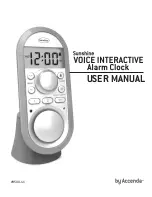
< t >
= True condition
< f >
= False condition
ii
: 01 = Locked; 02 = Status change; 03 = Locked with max accuracy; 04
= Fault; 05 = Daylight Saving Time change pending; ; 06 = Unlocked LED status (whether Unlocked LED On/O
↵
)
Ordinal Condition
Command:
/
{
ii
?
<
0
> /
:
,...,< n > /
;
< e >
} where:
<
0
>,<
1
>,...,< n >
= ordinal position
< e >
= Else condition
ii
: 01 = Time Quality (13 possible ordinals); 02 = Time Quality for True Time
format (5
possible); 03 = Time Zone Indicator (3 possible, 0=DST active, 1=Not active, 2=UTC)
Binary Hex
Value (worse case accuracy)
1111
F
Fault-clock failure, time not reliable
1011
B
10 seconds
1010
A
1 second
1001
9
100 milliseconds (time within 0.1s)
1000
8
10 milliseconds (time within 0.01s)
0111
7
1 millisecond (time within 0.001s)
0110
6
100 microseconds (time within 10
4
s)
0101
5
10 microseconds (time within 10
5
s)
0100
4
1 microsecond (time within 10
6
s)
0011
3
100 nanoseconds (time within 10
7
s)
0010
2
10 nanoseconds (time within 10
8
s)
0001
1
1 nanosecond (time within 10
9
s)
0000
0
Normal operation, clock locked
Table 7-2 List of Possible Time Quality Levels, Ordinal 01
Symbol ASCII Character
Accuracy
(space)
32
locked, maximum accuracy
.
46
Error
<
1 microsecond
*
42
Error
<
10 microseconds
#
35
Error
<
100 microseconds
?
63
Error
>
100 microseconds
Table 7-3 List of True Time Quality Levels, Ordinal 02
Using Ordinals and Conditionals
An ordinal returns an ASCII character or characters (e.g. 1, 2, 3,...., good, bad, etc.) for a requested value (e.g.
clock accuracy). A conditional returns an ASCII character or characters (e.g. 0, 1, locked, unlocked, etc.) based on a
true/false request (e.g. Is there a Fault?). Illustrated below are several examples of using ordinals and conditionals
when constructing a custom string. You can even construct standard strings to check your work. All the
ordinal/conditional examples below use the ASCII Standard broadcast string.
Ordinal 01.
This ordinal consists of 13 different accuracy values as listed in Table 7-2. Notice the ordinals (0, 1,
2,...,B, F) are all represented in this example. All need not be used as shown in the second example. This example
more closely follows the 1201B/C accuracy, not signaling a change until reaching 1 microsecond.
/T01/d:/h:/m:/s/{01?0/:1/:2/:3/:4/:5/:6/:7/:8/:9/:A/:B/:F/}/r
/T01/d:/h:/m:/s/{01?0/:0/:0/:0/:4/:5/:6/:7/:8/:9/;out of lock/}/r
Note that the accuracy values (e.g. 0, 1, 2,...,F) can be replaced with textual values. For example, note that the
value ”out of lock” in the second example replaced everything after ”9” in the first example.
Ordinal 02.
This ordinal consists of 5 different accuracy values as listed in Table 7-3.
Summary of Contents for 120A
Page 2: ......
Page 6: ......
Page 9: ...7 5 Glossary 34 7 6 Drawings 35 ...
Page 35: ...7 6 Clock Drawings ...




































